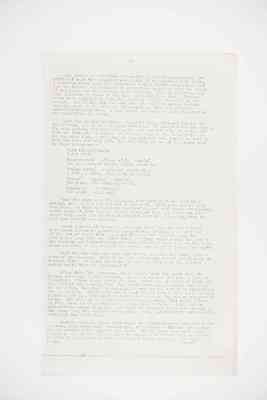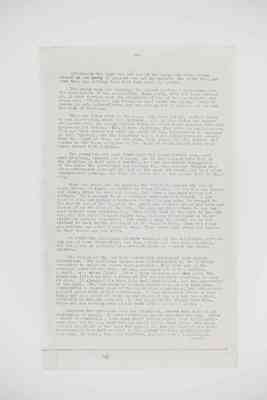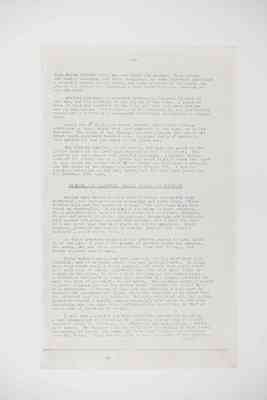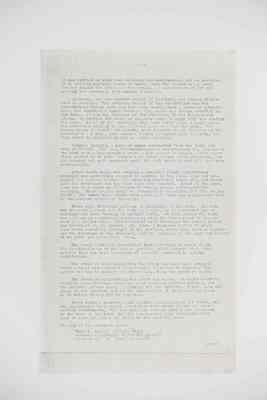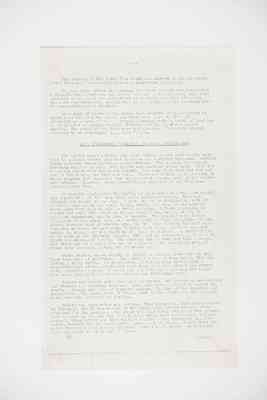Pages
11
-8-
All levity is forbidden on penalty of severe punishment. One informant said that laughter was liable to be punished with death. A sorcerer would kill the delinquent with a Kundīr (crystal.) And yet the Kamaran had recourse to ridiculous antics to test the power of the young men to maintain their gravity. The other extreme was also followed in order to try them and discipline them. Various means were employed to make them afraid. A hole was made in the ground. One of the old men went into it and represented various anials, such as the emu and the kangaroo. This was probably a totemic representation. A sham fight was another means resorted to for terrifying the boys.
Each boy is now allotted a separate camp, prepared for him by two natives, one of whom remains with him. He sleeps there one night. The next morning the novitiates, who are painted red, are taken out into the bush and at sunset are brought near to the main camp. As the sun goes down, a gin, who is also painted red, begins to sing so that the boys can hear her. The following is one of the songs sung on these occasions: -
Kung bondyiń-dimān Water shake
Ngań-daigarú dom'-an domān' buthān' The mullet-with little little close to.
Bur'-un burūn', tang'-gara kak'-kalīm, A fish, a fish, the mouth gleaming,
Windan' windan' buthān', The bank, the bank, close to,
Tang'-gara kak'-kalim'. The mouth gleaming.
When the boys hear the singing, they draw near the camp in a string, but are not yet allowed to enter it. They have now to camp together. To this common camp they retire, and with their attendants, march round it four times. Before daylight they are taken out from their camp again and at sundown brought near the main camp, when the same gin repeats her singing.
About a score of fires are now made in a line and are covered with green leaves to produce a dense smoke. Beginning at that end of the row of fires which is farthest from the women's camp, the novitiates jump into the first fire, clapping their hands, and repeat the jumping and hand-clapping at every fire till they come to the last, which is close to the camp of the women, and there they stay the night.
Next day the boys are once more taken out into the bush, each in care of two Kamaran. Some of the old men remain behind and prepare an immense fire. At night the boys are made to jump upon the red-hot embers until they are extinguished.
After this fire ceremony, there comes, upon the sixth day, the naming ceremony, called Wamaran, which is carried out like a sort of roll-call. Three large fires are made, round one or other of which all the natives are congregated. The youths with one attendant are at one of the fires, the other attendants, sharing in the duties of initiation, are at another. These call out to each boy in turn a name that has been selected for him, obviously an additional name to the one he received at birth. The boy, as he receives his name, responds, "Kai ngai" ("Here am I"). Each is then asked if he would like to have a wife, and an affirmative answer is given. At night the married women take charge of the young men, the married men camping apart. According to one account, this ends the initiation.
Another account, which represents the institution as protracted for a month, adds subsequent proceedings, as follows: - Efforts are continued to provoke both laughter and fear. But the boys have been forewarned by one of the old men what to expect, and advised how to behave, so that they may dare to throw stones at those trying to make them laugh.
(over)
12
-9-
Afterwards the boys are put out of the camp, and while being chased by one party of seniors are met by another, who catch them and toss them up,l etting them fall down upon the ground.
Following upon the tossing, the elders perform a corroboree for the delectation of the novitiates. Each youth, with his head covered up, is then carried upon the shoulders of one of the initiators, who cries out: "There's a big flood, we must cross the creek," This of course is only make-believe, but the boy is led to suppose he has run the risk of drowning.
They are taken back to the camp, and, when let go, another party of men approaches, ready for fighting. One of them gives two cooeys and immediately the young fellows begin to paint their helemon (shields), preparing for battle. But, before starting, they give one united cooey. They are then associated with one party of men, preparatory to engaging in real fighting, and the following day a fight takes place in ernest. When the fight is over, all the gins, both young and old, welcome the youths to the camp, clapping on the front of their thighs with their hands placed both together.
The young men are next taken into the large circle, and, amid much shouting, singing and yelling, one of the wizards cuts them on the shoulder or back with a crystal, to form cicatrices distinctive of the tribe the particular boy belongs to. One account affirms that other attendants also cut the boy on the back and chest, and that after considerable howling, the boys are taken out of the circle back to their camp.
When the incicions[sic] are healed, the novitiate enters the common camp, where, at first, no notice is taken of him. He has his own sleeping place, which he must not leave,, and where a gin must not as yet venture. What appears to be a marriage ceremony now occurs. A gin painted red, and having a cockatoo feather in her hair, is brought to the boy by one of the Kamaran, who pulls the feather out of her hair and places it on the hair of the boy. The gin may then return to her own camp without even touching him. When taken back to the camp by the old man, all the other females salute her, clapping thir hands on their thighs as already described. For about a week the young man is not allowed to look in the direction of the women's camp. Then the young gin returns and makes a camp by him. They touch each other and thereby they become man and wife.
No doubt the foregoing accounts combined of the initiation ceremonies are at best fragmentary, but they embody all that was essential, and the marriage ceremony as described above is a fresh and unique feature.
The bodies of the men were invariably ornamented with gaping cicatrices. The different tribes were distinguished by the patterns according to which the scars were arranged. They were cut on the muscular parts of the back, breast, and upper arm with a crystal, a shell, or a sharp flint. After a deep incision had been made, the wound was filled up with a paste of fat and powdered charcoal, to keep it open. It sloughed for some time and, when healed, had the appearance of two lips. The formation of certain cicatrices, as has been seen, constituted a painful part of the initiation ceremonies, but others were incised under much milder conditions. I once witnessed three or four being cut on a youth of about twenty years of age by his own mother, evidently at his own request. He was lying on the ground face down, while she was carving away at his back with a piece of glass.
Besides the incisions made for adornment, others were made as an expression of grief, In this matter the women exceeded the men. After a night of mourning, I have seem their bodies marked with small incisions from top to toe, with the dry blood still about them. The women incised the front of the head for grief, the men the back of the head. Occasionally they paid respect to the memory of white people in the same way. My uncle, Mr. John Mortimer, had stood by a blackfellow,
(over)
13
-10-
Buyu Marom (Calves Fat), who was tried for murder. This native was really innocent, and being acquitted, he ever afterward cherished a grateful regard for my uncle, and when he heard of his death, he showed his sorrow by inflicting a deep wound with his tomahawk on his own head.
Another practice of personal adornment, followed by most of the men, was the piercing of the septum of the nose. A piece of bone or wood was inserted in the hole and thus worn when the man was in full dress. After contact with civilisation,, the perforation occasionally served as a convenient receptacle for holding a tobacco pipe.
Among the Bī dhala, or coast natives, there were certain practices in vogue which were not observed by the Wapa, or inland natives. The women of the Bīdhala, in some places, had one of the front teeth purposely knocked out. In other parts of Australia this mutilation was performed on the young men.
The Bīdhala females, in childhood, had also the point of the little finger of the left hand removed at the first joint. The process was very simple and probably painless. A slender string made of the strong web of a spider was wound tightly round the joint By this means the circulation of the blood was effectually stopped, and the point of the finger ultimately dropped off. A similar practice prevailed at the Daly River, not far from Port Darwin in the Northern Territory.
DISEASE AND TREATMENT, DEATH, BURIAL AND MOURNING
Before they became tainted with diseased contracted from Europeans, the aborigines wre a healthy and hardy race. Their outdoor life and the necessary struggle for existence kept them toned up physically. No epidemics are known to have occurred. Their maladies were such as would arise from accident, exposure, strain and errors of diet. Indigestion, rheumatism and toothache were common trougles.{sic} Leprosy was unknown, but I knew the case of a man whose nose was in a state of chronic gangrene. Heart disease, probably the result of strain, judging from cases I witnessed, would not be rare.
In their pristine condition the natives seemed to have lived to an old age. I knew a few people of seventy years and upwards. One woman, who use to be carried about from camp to camp, had become wizened like a mummy.
Their medical skills was very limited, for the most part mere illusion, and of surgical skill they had virtually none. To allay pain they would apply a tight bandage, and sores they would cover over with clay or ashes. Ligatures were fastened above boils or wounds on the limbs, to give relief by checking the circulation. A favourite treatment of local plain was for the Manngur (wizard) to suck the part if accessible to his mouth. The sucking would of itself relieve inflammation and the doctor would increase the relief by a mild deception. A friend of mine saw one treating a sore part by suction and expectorating blood, which was supposed to be drawn from the affected part in the patient. But as a matter of act[sic], the doctor showed my friend a kundīr (quartz crystal), with which he had been lacerating his own gums while performing the operation, so that it was a case of bleedng by proxy.
I once saw a similar but more elaborate process of bleeding. A boy complaining of a pain in the stomach, had one end of a cord fastened about the abdomen. The other end was immersed in a vessel with water. The Manngur held the cord near the middle by both hands, see-sawing it across his gums, and from time to time expectorating into the vessel. This was supposed to be a bleeding of the patient.
(over)
14
-11-
It was carried on with much patience and seriousness, and as medicine to be efficacious must needs be nasty, when the opertion is over, the boy drinks the potion in the vessel. I was scowled at for regarding the operation with amused credulity.
Sickness, not the obvious result of accident, was always attributed to sorcery. The ordinary belief of the blackfellow who had mysteriously become sick was that some enemy, from a place of concealment, had launched a magic stone at him, which had become embedded in his body. It was the business of the sorcerer, by his hocus-pocus tricks, to extract the stone or whatever other foreign body was causing the pain. As if on the principle that like cures like, a magic stone was sometimes applied to the affected part ot[sic] allay the pain. The stones known as kundīr and minkom, when imagined to be residing in the sorcerer's own body, were assumed causes of exceptional vitality, but they could be utilised by him as lethal weapons.
Ginggil ginggil, a kind of mange contracted from the dogs, was very prevalent. The only treatment applied was pressing the pimples of the rash with a dull-pointed stick a few inches in length. This operation seemed to be much enjoyed - at least it was often practised, and was carried out with apparent zest, the body being picked all over very methodically.
After death there was usually a cannibal feast, and profound mourning was invariably engaged in nightly by the whole camp and prolonged for several weeks. The skin was sometimes taken off, and parts like the knee-caps and the toes were also removed. Bones of the arms, legs and head would be fractured to obtain pieces convenient for carrying. These relics would be treasured by relatives for five or six years. The women would carry them about with them and would store them in the cosiest corner of the camp.
There were different methods of disposing of the dead. One mode was to erect a stage for the body on a tree, or to construct one of saplings and bark resting on upright forks. On such stages the body was left until completely desiccated, when the bones would be deposited in a hollow tree. After contact with Europeans the common method was interment in the ground. One grave I knew was marked by small logs being carefully arranged on the surface, which were said to represent the brothers of the deceased, and the position of the logs was intended to point out where they lived.
The young folk were prohibited from partaking of human flesh. The distinction as to who should partake, would suggest that other motives than the mere appeasing of appetite conduced to uphold cannibalism.
The strip of skin taken from the thigh was sometimes wrapped round a spear and employed as a magical indicator to discover the person who had by sorcery or other cause, been the agent of death.
The duration of mourning was about six weeks. At night mourners could be seen flitting about the camp carrying glowing torches, for the purpose, it was said, of driving off the spirits. I have seen the gleam of the torches, but as the explanation of their use was given me by whites it may not be reliable.
Every night a general, loud wailing was sustained for hours, and was accompanied by personal laceration with sharp flints or other cutting instruments. The men would be content with a few incisions on the back of the head, but the women would gash themselves from head to foot and allow the blood to dry upon the skin.
The cry of the mourners was: -
"Ngata! ngata! mīmin! mīmin! Wuthung nganyunggai balomathi gindī!" "Brother my is dead oh dear!"
(over)
15
-12-
The meaning of the first four words was unknown to my informant. After this wail there would follow a long-drawn ululation.
To join with others in mourning for their friends was considered a sympathetic, courteous and proper action. A blackfellow, once complainging to me about the unkindness of another, regarded it as all the more reprehensible, seeing that he had joined in the mourning for the ungrateful man's brother.
As a sign of mourning the women tied bunches of emu feathers in their hair all over the head, and these were left to drop off gradually in course of time. During mourning certain kinds of food had to be avoided as mundha (tapu). Fasting for the dead was called ngarīn. The names of the dead were not uttered. They were usually referred to as kananngur, ie., poor fellow.
ART, IMPLEMENTS, UTENSILS, WEAPONS, CORROBOREES
The tribes under notice, like most tribes on the east coast, were kept to a large extent isolated by river and mountain barriers. Several facts indicate their peculiar primitiveness. The wommera for spearthrowing was not in use. The spears were without stone tips; they had no prongs apart from the shaft itself. The only barb they had was cut out of the solic, and this was rare. There was little or no carving on their weapons for ornament, and any coloured designs were of the simplest outline. Besides, their manufactured articles of any kind were comparatively few.
As regards implements the muyīm, or stone-axe, was the most useful and important. Of the axes there were different makes. They were chipped and ground to an edge. I have two in my possession, both of diorite. One is 4 1/2 in. long, 1 1/4 in. thick, and when in its perfect state must have been nearly as broad as long. Without a hangle, it weighs 15 1/2 ozs. The other is 6 3/4 in. long, 4 in. broad, 2 1/2 in. in greatest thickness, and 2 1/2 lbs. in weight. The handles were formed of pieces of the scrub vine or a withy doubled round the middle of the stone, secured with grass-tree gum, and the ends forming the haft held together by being wrapped round tightly with cord. Another make was unique in shape, and was known by the name of waggara. A specimen is to be seen in the Brisbane Museum. The head is cylindrical, about 2 in. thick and 4 1/2 in. in length. The cutting end is bevelled like a wedge, the other end is rounded for use as a hammer. The handle is wrapped round with emu-skin, having the feathers on.
Stone knives, known simply as dhakkē (a stone), were also in use. They were made of quartzite. One, that I have, is very broad, the edge having a large curve. It shows marks of having been flaked with a straight-edged stone, which must have been used as a chisel and struck with, probably, a peice of wood. It may have had a handle, but could have been used without one for flaying and dissecting game.
Flints and shells were also used as knives, and served as spokeshaves and chisels for dressing weapons. Bone awls were employed to assist in sewing. String was made of kangaroo sinews, the fur of the squirrel and human hair. The inner bark of trees, such as the currajong and stringybark, was also utilised as cordage.
Before the tinder-box was obtained from Europeans, fire was produced by friction, the flower-stalks of the grass tree (Xanthorrhoea) being employed for the purpose. One stalk was laid horizontally on the ground. Into a notch in it, the end of a lighter stem, held vertically, was inserted. This latter was then twirled rapidly round backwards and forwards, between the two hands until ignition took place. Round about the notch there was placed some dry bark, rubbed soft, which easily caught fire and could be blown into a flame. (over)
